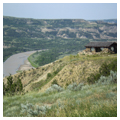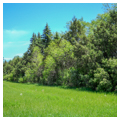New Deal–era work relief projects were transformative symbols of federal intervention and had profound impact on North Dakota’s built landscape. The Civil Works Administration CWA, Works Progress Administration WPA, Civilian Conservation Corps CCC, and Public Works Administration PWA fueled the state’s economy in the 1930s, providing employment opportunities that resulted in the construction of buildings, landscapes, and infrastructure.
Art Deco, Moderne, and a picturesque rustic mode characterize most Great Depression–era buildings in the state. The first two styles were regarded as efficient and forward looking, well suited to public buildings. Most of the structures funded by the various federal agencies were also technologically advanced. The picturesque rustic manner is embodied in many of the projects constructed by the CCC and WPA. Given the paucity of native building materials, fieldstone came to be associated with these buildings. Handcrafting rough timbers and metalworking were labor-oriented material technologies well suited to the CCC camps and WPA labor force.
Buildings of all types were constructed in communities of all sizes in every part of the state. State hospital facilities were expanded or improved, notably a hospital ward building at the state mental institution in Jamestown. The PWA funded a dormitory at the School for the Feeble-Minded in Grafton and improvements at the infirmary for tuberculosis patients at San Haven much of San Haven has been dismantled since it was closed in 1987. State parks and historic sites were substantially expanded, as was the Theodore Roosevelt National Park (North Unit and South Unit). A few projects undertaken as agricultural experiments included small farmsteads for relocated coal miners in a planned community near Burlington devastated by river flooding in 1969 and 2011, where standardized designs for farmhouses, barns, and outbuildings were employed.
The Soil Conservation Service constructed dams and irrigation water projects to conserve “submarginal lands.” To mitigate wind erosion throughout the Great Plains region an impressive Experimental Forest was established in 1931, promoting the shelterbelt initiative of the Prairie States Forestry Project. CCC and WPA crews planted still-visible shelterbelts, collaborating with work relief labor contributed by individual farmers. Other CCC camps focused on mitigating the effects of drought, soil erosion, and degradation of wildlife habitat. Wildlife refuges were established experimentally in North Dakota in the 1930s, and have since grown to be part of the largest and most extensive network of waterfowl habitat preserves in the world.
Federal investment in small communities in the 1930s affirmed that these isolated places justified the basic amenities of civic life. Work relief programs insisted on quality in design and construction in their projects and prioritized long-term usefulness. The result was civic improvement in many faltering small communities. The impact of federal work relief projects in North Dakota is palpable and pervasive. In the current era of disposability, the wisdom of Depression-era public investment has been demonstrated by the continued utility of the constructed work.
Writing Credits
If SAH Archipedia has been useful to you, please consider supporting it.
SAH Archipedia tells the story of the United States through its buildings, landscapes, and cities. This freely available resource empowers the public with authoritative knowledge that deepens their understanding and appreciation of the built environment. But the Society of Architectural Historians, which created SAH Archipedia with University of Virginia Press, needs your support to maintain the high-caliber research, writing, photography, cartography, editing, design, and programming that make SAH Archipedia a trusted online resource available to all who value the history of place, heritage tourism, and learning.






